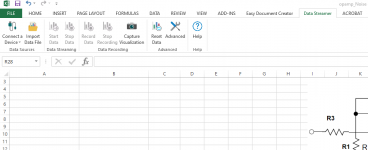Someone asked why not just use the Audio Precision FFT to analyze noise -- when I tried it initially the results didn't seem correct. Then Jan pointed me to a macro AP had built "FFT Scaling for Noise" -- this corrects level for the different measurement methodologies, ie. equiripple vs none, etc., and corrects the bin size so you're getting results in Volts^2/Hz or Volts/RtHz
When WJ did his seminal regulator articles with a System One in 1995, i.e. the pre-digital version of the analyzer, he mentioned that the bandpass filter in the analog analyzer had a filter factor of SQRT(0.2316). When I got my SYS2722 the folks at AP told me that the bandpass filter used the same factor.
I thus went about writing a macro which took the low level measurements, divided by the gain and square root of frequency and the filter factor to compare input noise.
I am happy to report that the results of both techniques yield results which are entire comparable within a percent or so -- pretty good.
Oh, one more thing -- with the analog analyzer and sweep function -- you can use a "table sweep" and leave out those nasty 50 (or 60) Hz bad apples, just creating a sweep table which cuts out the shoulders of the BP function.
To test, I set up a circuit with an OPA627 for gains of 10X and 100X -- but using resistor Rg and Rf values which varied by a factor of 10 and 100. The noise above the level of the opamp is a function of kT(Rf||Rg)*BW. (When Rg is less than ~100R its effect is almost inconsequential).
The FFT Scaling macro is a battle between precision and accuracy. If you search for a huge number of datapoints you'll have to download the data and RMS the values. With the analog analyzer you can use fewer datapoints and RMS at each frequency to come up with a meaningful answer.
When WJ did his seminal regulator articles with a System One in 1995, i.e. the pre-digital version of the analyzer, he mentioned that the bandpass filter in the analog analyzer had a filter factor of SQRT(0.2316). When I got my SYS2722 the folks at AP told me that the bandpass filter used the same factor.
I thus went about writing a macro which took the low level measurements, divided by the gain and square root of frequency and the filter factor to compare input noise.
I am happy to report that the results of both techniques yield results which are entire comparable within a percent or so -- pretty good.
Oh, one more thing -- with the analog analyzer and sweep function -- you can use a "table sweep" and leave out those nasty 50 (or 60) Hz bad apples, just creating a sweep table which cuts out the shoulders of the BP function.
To test, I set up a circuit with an OPA627 for gains of 10X and 100X -- but using resistor Rg and Rf values which varied by a factor of 10 and 100. The noise above the level of the opamp is a function of kT(Rf||Rg)*BW. (When Rg is less than ~100R its effect is almost inconsequential).
The FFT Scaling macro is a battle between precision and accuracy. If you search for a huge number of datapoints you'll have to download the data and RMS the values. With the analog analyzer you can use fewer datapoints and RMS at each frequency to come up with a meaningful answer.
Last edited:
measuring the noise of an opamp opens the door to a lot of questions. Since an opamp has 2 inputs you would want to know which is noisier if one is. Then if one input has higher current noise than the other and so forth.
I have been repairing a Quantech 5173 and have had to dig into a lot of this to start to get meaningful results. The Quantech documentation is almost complete but they left out a lot of important details.
I have been repairing a Quantech 5173 and have had to dig into a lot of this to start to get meaningful results. The Quantech documentation is almost complete but they left out a lot of important details.
Jack, that's!
Will you be making that macro available for us?
Jan
Sure -- but if I could figure out how to get the AP to communicate with Excel via the "Datastreamer" it would take a fraction of the time compared to a VB application like APBasic. (Otherwise I just export the data to Excel as *.CSV)
Jack what is this 'data streamer'- is it an APB function? I can look into it.
Jan
It's an Excel "Add-in" -- in beta -- was set up for microchips, arduino etc.
Attachments
- Status
- This old topic is closed. If you want to reopen this topic, contact a moderator using the "Report Post" button.
- Home
- Design & Build
- Equipment & Tools
- Audio Precision "FFT Scaling" vs Analog Bandpass and Noise
